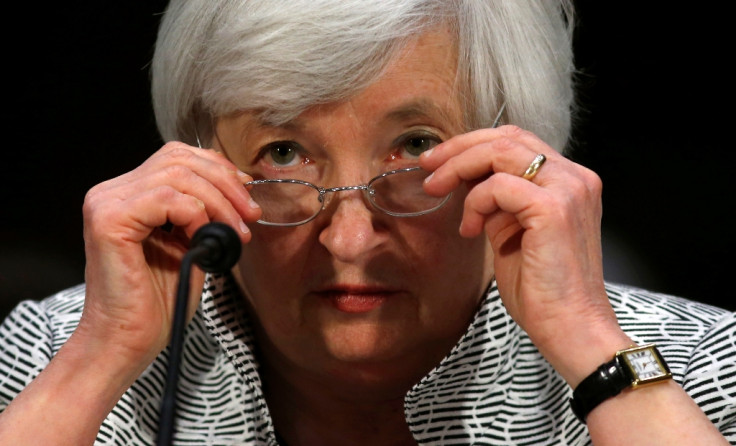Central Banks Watch: FOMC, Yellen in Focus While Norway, Switzerland, Malaysia, Thailand, South Africa and Nigeria to Set Rates

The week to 19 September will be marked by a big Fed event on Wednesday: the FOMC rate decision followed by a press conference by the central bank chief.
Most people expect the world's largest economy to provide clearer interest rate cues a month before the bank stops buying back bonds from the market.
More central banks will be in focus during the week: the Swiss National Bank and Norges Bank from the G10 world are scheduled to set rates, in addition to Malaysia, Nigeria, South Africa and Thailand, from the emerging world.
Some central banks will be in the news for other things: the Bank of England and the Reserve Bank of Australia will release the minutes of the latest policy review meetings while the chiefs of the Bank of Japan and Bank of Canada are scheduled to speak at separate events.
The Federal Reserve is on track to end the tapering of its asset purchase programme in October. The current pace of MBS (mortgage-backed securities) purchase is $5bn and Treasury purchase $15bn. The Fed funds rate is 0.25%.
In the August review, the Fed said it would keep the main policy rate near zero for an extended period even after ending the quantitative easing as scheduled in October given the weakness of the labour market.
As per the August jobs data, non-farm payroll addition in the US dropped to 142,000 from 212,000 in July while analysts had been expecting an increase to 225,000. However, Charles Plosser, a senior Fed official, said the longer-term picture is promising.
"I prefer to look at longer-term trends rather than monthly numbers that are still subject to revision," Plosser said, adding that the Federal Reserve must acknowledge and prepare the markets for the fact that interest rates may begin to increase sooner than previously anticipated.
There were a lot of economic data prints showing the strength of US economic recovery.
Durable goods orders soared 22.6% in July, compared to the previous month's 2.7% and a market consensus of 7.5%. US consumer confidence rose to 92.4 from 90.3, when analysts were expecting a drop to 89.0.
The GDP data showed that the economy expanded 4.2% in the second quarter, after contracting 2.1% in the first, beating analysts' forecast of a 3.9% growth.
Most market participants expect the Fed to start hiking rates in 2015, but some forecast it in the first-half while many see it happening towards the end of the year.
Switzerland and Norway
The SNB is expected to leave the target range for the three-month Libor on hold at 0.0–0.25% and the EUR/CHF floor rate at 1.20, at the decision on 18 September.
Leaving the rates steady at its 19 June meeting, the SNB had cited concerns about volatility on the financial and foreign exchange markets, but it had increased its inflation forecast for 2014.
The market will look for additional central bank comments about the price pressures and growth outlook for the Swiss economy.
Norges Bank too will announce its rates on Thursday and it is unlikely to alter the main policy rate from 1.5% this time.
August data showed that core inflation has eased to 2.24% year over year from 2.64% in July. The central bank may comment about the recent performance of the Norwegian krone as well.
The krone has fallen to a one-month low versus the euro despite the broad weakness of the common currency and has plunged to a four-year low versus the dollar.
Others
The Thai central bank will set rates on 17 September and the South African and Malaysian central banks on 18 September and their Nigerian counterpart the next day.
Thailand had kept the main lending rate unchanged at 2% at the 6 August review but at the 17 July meeting, the South African Reserve Bank had raised the repo rate by 25 basis points to 5.75% citing inflationary pressures.
On 10 July, the Bank Negara Malaysia raised the overnight policy rate for the first time in three years by 25 basis points to 3.25% in order to curb inflationary pressures and household debt.
The floor and ceiling rates of the corridor for the overnight policy rate were correspondingly raised to 3.00% and 3.50%, respectively.
Nigeria's central bank held the benchmark interest rate at 12% at the July meeting, but has hinted at a gradual rate cut in the next year as price pressures ease, making the upcoming reviews significant.
Beyond Rates
The Reserve Bank of Australia will release the minutes of its last meeting on Tuesday and the monthly bulletin and annual report on Thursday. The central bank had left the main rate unchanged at 2.5% at the August review.
Given the sharp losses in the Australian dollar in recent weeks, deliberations of the board members on the currency will be keenly watched.
The BoE bulletin for the third quarter will be published on 16 September and the MPC minutes on 17 September. Last time, unexpectedly, two members had voted for a hike in the bank rate.
BoJ chief Haruhiko Kuroda will speak on Tuesday as well as on Thursday and BoC governor Stephen S Poloz on Tuesday.
The central bankers may comment on the recent fall in the yen and the Canadian dollar apart from discussing general ideas about the strength of the economy and price pressures.
© Copyright IBTimes 2024. All rights reserved.






